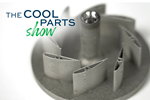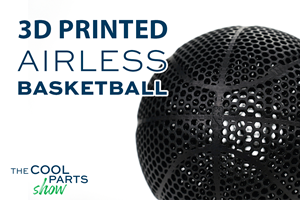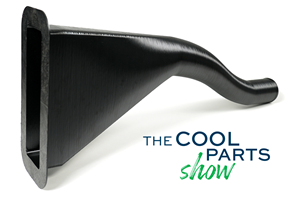Shark scales — or more accurately, denticles — have geometries that help to reduce drag, enabling sharks to swim at high speeds. The phenomenon is not fully understood; in fact, some researchers are using 3D printed models in experiments designed to investigate the effects of denticle size, arrangement and orientation on fluid flow. But in the meantime, designers and manufacturers are already taking advantage of what we do know about shark denticles to apply similar geometries to problems in the human world, such as gas turbines and aerodynamics. In this bonus episode of The Cool Parts Show, we explore research and applications based on shark anatomy, and share two Cool Parts with denticle-inspired features. (Find the episode about the first in our archive, and subscribe to our e-newsletter or channel to be notified when the second is posted later this summer!) | This episode of The Cool Parts Show brought to you by Carpenter Additive
The Cool Parts Show is a video series from Additive Manufacturing Media that explores the what, how and why of unusual 3D printed parts. Watch more here.
Have a cool part to share? Email us.
Related Resources
- Gas swirlers developed by students at Penn State University, episode #42
- Cold plate for an electric race car, episode #51
- Research into drag reduction using 3D printed shark-skin-like surfaces
- A study of the aerodynamic effects of denticle-inspired surfaces on the suction side of airfoils
- MicroTau, an Australian company that 3D prints microscopic denticle-like structures onto aircraft
- Another Cool Part that makes use of biomimicry
Transcript
Peter Zelinski
I'm Pete.
Stephanie Hendrixson
I'm Stephanie.
Peter Zelinski
Welcome to a bonus episode of The Cool Parts Show.
Stephanie Hendrixson
That's right. It is unofficially officially Shark Week on The Cool Parts Show.
Peter Zelinski
We want to talk about sharks because sharks have found their way into two episodes of The Cool Parts Show.
Stephanie Hendrixson
That's right. We did one episode with a group of students from Penn State University who are working on developing a better gas swirler. And they discovered that by adding these little shark scale details to their air foils, they can create more turbulence and create a more effective design.
The other example was a cold plate, basically a very intricate heat exchanger that was developed for a team of students at the University of Milan for an electric race car. And they used these shark scales on the inside of this heat exchanger to sort of direct the flow of coolant and cool more efficiently.
Peter Zelinski
So shark scales, if that's even the right word. But it turns out that the outer surface of sharks, the skin of sharks on a microscopic level, have these geometric forms that seemingly help with fluid flow and help the sharks swim more efficiently.
Stephanie Hendrixson
Yeah, so scale is not exactly the right word. They're actually called denticles. They're a little bit more like teeth than they are like scales. And a shark's body is just covered with these. They sort of change geometry across their anatomy. And sharks can actually control the angle of the denticles to help them swim faster in the ocean. And sort of what's happening is that each one of these denticles is creating a vortex of fluid and that's reducing drag. And that's sort of how we think this works. And so people have discovered that not only do these denticles and their designs work for sharks, they can also be applied to these very human problems as well.
Peter Zelinski
Yeah, we kind of nerded out on this. We discovered technical papers from various researchers, biology researchers who are studying this question, how do these denticles work to reduce drag? And they're using 3D printing to do it. We discovered researchers using 3D printers from Objet, from FlashForge, but they're making these geometric forms like the denticles, these geometric forms identical to the denticles, that'll help them study the fluid flow around these forms and understand what's happening here.
How does the drag reduction work? And it seems like we don't yet know the exact mechanism, but it has to do with the fluid turbulence, with vortices in the fluid and with features called separation bubbles within the fluid turbulence that all add up to a reduction in the force that the fluid has upon this form.
We even came upon a company in Australia that is developing a coating for aircraft that's based on this geometry. And they see this as a five and a half billion dollar opportunity because the drag reduction on an aircraft would translate into a 2% reduction in fuel use. Cut fuel use by 2%, multiplied by all the commercial aircraft out there. That would be five and a half billion dollars in fuel that doesn't have to be used.
Stephanie Hendrixson
All right. So we found all of these applications for these shark denticle geometries in research and in real-world products. And something that I found really interesting here is that the 3D printer actually becomes the enabler to these geometries. So these are features that can be really, really tiny, but they can be difficult to produce. They could end up being expensive, and 3D printing is a way to add those features to create these geometries. And we've seen everything from those metal 3D printers that were used in the two episodes that we mentioned, down to more affordable machines, down to desktop 3D printers. And these are all different ways to achieve that geometry for these different applications.
Peter Zelinski
Biomimicry, like that's sort of the point of what we're talking about here. It's looking to nature and the way that it solves problems and trying to derive engineering lessons from that. And the challenge has been that these forms that nature as an engineer comes up with are complicated. And we don't necessarily know exactly how they work.
They're geometrically very intricate and very difficult to produce, except 3D printing is the enabler, just like you say. And 3D printing makes it easy to make these forms, so easy that students, student engineers, student researchers, as we saw in our past episodes, they can apply these natural forms themselves and just see if their use of biomimicry maybe can help with fluid flow in their engineering challenge that they're facing.
Stephanie Hendrixson
So if you want to dive deep into sharks, 3D printing and biomimicry, see those links in the show description. Thanks for watching.
Related Content
This Drone Bird with 3D Printed Parts Mimics a Peregrine Falcon: The Cool Parts Show #66
The Drone Bird Company has developed aircraft that mimic birds of prey to scare off problem birds. The drones feature 3D printed fuselages made by Parts on Demand from ALM materials.
Read MoreAirless Basketball Shows Promise of 3D Printed Lattices: The Cool Parts Show Bonus
Successfully matching the performance of a standard basketball demonstrates the control possible over the mechanical properties of digital materials.
Read MoreAircraft Ducts 3D Printed in Composite Instead of Metal: The Cool Parts Show #68
Eaton’s new reinforced PEKK, tailored to aircraft applications, provides a cheaper and faster way to make ducts compared to formed aluminum.
Read More3D Printed Cutting Tool for Large Transmission Part: The Cool Parts Show Bonus
A boring tool that was once 30 kg challenged the performance of the machining center using it. The replacement tool is 11.5 kg, and more efficient as well, thanks to generative design.
Read MoreRead Next
3D Printing for Better Flame From a Gas Turbine Swirler: The Cool Parts Show #42
A Penn State gas turbine researcher turns to additive manufacturing graduate students to help face the challenge of swirler optimization.
Read More3D Printed Heat Exchanger Uses Gyroids for Better Cooling | The Cool Parts Show #43
Replacement heat exchanger for a helicopter is half the size and delivers 4× the cooling, thanks to a geometry that could only be made via additive manufacturing.
Read MoreAlquist 3D Looks Toward a Carbon-Sequestering Future with 3D Printed Infrastructure
The Colorado startup aims to reduce the carbon footprint of new buildings, homes and city infrastructure with robotic 3D printing and a specialized geopolymer material.
Read More

.jpg;width=70;height=70;mode=crop)

















